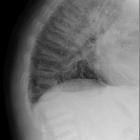multiple endokrine Neoplasie Typ 1



Multiple endocrine neoplasia type I (MEN1), also known as Wermer syndrome, is an autosomal dominant genetic disease that results in proliferative lesions in multiple endocrine organs, particularly the pituitary gland, islet cells of the pancreas and parathyroid glands.
There are other multiple endocrine neoplasia syndromes and these are discussed separately.
Clinical presentation
Primary hyperparathyroidism is the commonest presentation, followed by pancreatic islet cell tumor with associated hypersecretion syndromes; gastrinomas are most common and associated with Zollinger-Ellison syndrome .
Pathology
The abnormality is related to a tumor suppressor gene located on chromosome 11q13. MEN type I is an autosomal dominant syndrome characterized by :
- pituitary adenomas
- prolactinoma (most common)
- 30% of patients
- islet cell tumors of the pancreas
- gastrinoma (most common) followed by glucagonoma
- 50-80% of patients
- a significant cause of mortality
- proliferative parathyroid gland lesions
- parathyroid hyperplasia (most common)
- hyperparathyroidism is seen in 80-95% of patients
- parathyroid adenoma
- parathyroid carcinoma (rare)
- parathyroid hyperplasia (most common)
Handy mnemonics for recalling MEN type I:
- PPP or PiParPanc
Associations
In addition to the aforementioned characteristic lesions involving the pituitary, parathyroid, and pancreas, numerous other lesions are encountered with greater frequency in patients with MEN1. These include:
- lipomas
- angiofibromas
- adrenal cortical lesions
- adrenal adenomas
- adrenocortical hyperplasia
- cortisol-secreting adenomas
- adrenal carcinomas (rare)
- carcinoid tumors
- hepatic focal nodular hyperplasia
Treatment and prognosis
Treatment is directed to each individual manifestation. These are therefore discussed separately.
Pancreatic malignancy is the leading cause of mortality in MEN type I.
History and etymology
MEN1 was first characterized by P Wermer et al. in 1954 .
See also
- MEN1 (Wermer syndrome)
- MEN2
- MEN2a (Sipple syndrome)
- MEN2b (mucosal neuroma syndrome)
- familial medullary thyroid carcinoma
- MEN4
- Carney complex
Siehe auch:
- Lipom
- Nebennierenadenom
- Karzinoid
- primärer Hyperparathyreoidismus
- Hypophysenadenom
- Nebennierenrindenkarzinom
- Gastrinom
- MEN IIa
- MEN IIb
- Multiple endokrine Neoplasien Typ 2
und weiter:

 Assoziationen und Differentialdiagnosen zu multiple endokrine Neoplasie Typ 1:
Assoziationen und Differentialdiagnosen zu multiple endokrine Neoplasie Typ 1:







